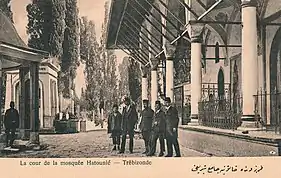Gülbahar Hatun (wife of Bayezid II)
Gülbahar Hatun (Ottoman Turkish: کل بهار خاتون; c. 1453 – c. 1505), also known as Ayşe Hatun[5][6] was a consort of Sultan Bayezid II and the mother of Sultan Selim I of the Ottoman Empire and the grandmother of Sultan Suleiman the Magnificent.[7]
| Gülbahar Hatun | |||||
|---|---|---|---|---|---|
 The tomb of "Gülbahar Hatun" is located inside "Gülbahar Hatun Mosque" in Trabzon | |||||
| Born | Ayşe[1][2] or Gül-Bahar bint-i Abdû's-Samad[3] c. 1453 Elbistan, Dulkadir Principality | ||||
| Died | c. 1505 (aged 51–52) [4] Trabzon, Ottoman Empire | ||||
| Burial | |||||
| Spouse | Bayezid II | ||||
| Issue | Selim I | ||||
| |||||
| Father | Alaüddevle Bozkurd Bey[2][5] or Abdû's-Samad[3] | ||||
| Religion | Sunni Islam | ||||
Names
One of the oldest references Cenabî History gives her name as Ayşe Hatun. According to Sicill-i Osmanî her name is Gülbahar Hatun, while Alderson gives her name as Ayşe Hatun, as well.[4]
Origins
Gülbahar Hatun and Ayşe Hatun were never different women. The theory of Gülbahar Hatun's origins make her a different woman from Ayşe Hatun as both women had same maiden name, Ayşe in both the origins and were also married in the same year. The theories of her background are:
- The Ottoman inscription (vakfiye) describes her as Hātun binti Abd-us-Samed (Daughter of Abd-us-Samed),[3] which supports the view that she was a non Muslim who later converted to Islam. Abd-us-Samed, meaning Servant of God, was the anonym that was applied to many Balkan and Anatolian Christians who converted to Islam in the classical Ottoman period.[8][9]

The origin described above is also described for Emine Gülbahar Hatun, wife of Mehmed the Conqueror, mother of Sultan Bayezid II and the grandmother of Sultan Selim I. The origin described below is the most acceptable origin of Gülbahar Hatun.
- According to this origin (most sources have claimed that) she was the daughter of Alaüddevle Bozkurt Bey, the eleventh ruler of the Dulkadirids centered around Elbistan in Kahramanmaraş. Her real name was Ayşe[2] and was renamed Gülbahar after her marriage.[11][12]
However, according to the Greek historian Constantine Paparrigopoulos, Gülbahar Hatun was a Pontic Greek called Maria, who was the daughter of a priest from Livera village, Maçka district.[13]
Life
Bayezid married her in 1469 at Amasya. When Bayezid was still a şehzade ("Ottoman prince") and the governor of Amasya sanjak when she gave birth to Selim I in 1470. When Mehmed the Conqueror died in 1481, Bayezid moved to Constantinople, the capital of the Ottoman Empire, along with his family to ascend the throne.
According to Turkish tradition, all princes were expected to work as provincial governors (Sanjak-bey) as a part of their training.[14] Mothers of princes were responsible for the proper behaviour of their sons in their provincial posts.[14] In 1495 was sent to Trabzon sanjak and then in 1511 to Samandıra, and Gülbahar accompanied him.
However, she herself never became recognized as a Valide Sultan because she died in 1505 before Selim's accession to the throne. Her tomb is located in Gülbahar Hatun Mosque, Trabzon.[14] It was built in 1514 in honour of his mother and was restored in 1885.
See also
References
- Diyanet İslâm Ansiklopedisi: I. Selim, vol: 36, pages: 407.
- Necdet Sakaoğlu (2008). Bu mülkün kadın sultanları: Vâlide sultanlar, hâtunlar, hasekiler, kadınefendiler, sultanefendiler. Oğlak publications. p. 136. ISBN 978-975-329-623-6. (The name of the real biological mother of Yavuz Sultan Selim is given as Âişe Hâtun of the Beylik of Dulkadir in İ. H. Danişmend's İzahlı Osmanlı Tarihi Kronolojisi).
- Necdet Sakaoğlu (2008). Bu mülkün kadın sultanları: Vâlide sultanlar, hâtunlar, hasekiler, kadınefendiler, sultanefendiler. Oğlak publications. p. 136. ISBN 978-975-329-623-6. (Gülbahar binti Abdüssamed was the Ottoman Sultan Bayezid II's eighth wife who had been sent to join his son Selim I, the governor of Trebizond Eyalet).
- Necdet Sakaoğlu (2008). Bu mülkün kadın sultanları: Vâlide sultanlar, hâtunlar, hasekiler, kadınefendiler, sultanefendiler. Oğlak publications. p. 135. ISBN 978-975-329-623-6. (It is disputed if the names of Âisha and Gül-Bahar refers to two different persons, or indicates two different names of the same individual, i.e., the real biological mother of Yavuz Sultan Selim).
- Diyanet İslâm Ansiklopedisi, vol: 36, pages: 407–414, 2009 (Âişe Hâtun was the daughter of Alaüddevle Bozkurt Bey)
- Bahadıroğlu, Yavuz, Resimli Osmanlı Tarihi, Nesil Yayınları (Ottoman History with Illustrations, Nesil Publications), 15th Ed., 2009, page 157, ISBN 978-975-269-299-2
- Ahmed Akgündüz, Said Öztürk (2011). Ottoman History: Misperceptions and Truths. Oxford University Press. ISBN 978-90-90-26108-9.
- "Consorts Of Ottoman Sultans (in Turkish)". Ottoman Web Page.
- Anthony Dolphin Alderson (1956). The Structure of the Ottoman Dynasty. Clarendon Press.
- Diyanet İslâm Ansiklopedisi: I. Selim, vol: 36, page: 407. (pdf)
-
- "Yavuz Sultan Selim Han". Republic of Turkey Ministry of Culture and Tourism. Archived from the original on 2011-04-17. Retrieved 2009-02-06.
- "Mother Of Yavuz Sultan Selim". Osmanlı Araştırmaları Vakfı (Ottoman Research Foundation). Archived from the original on 2010-12-08.
- Osmanlıdan Cumhuriyete Trabzonlu simalar ve Trabzon'un köklü aileleri. Mehmet Akif Bal. 2005. ISBN 978-975-00451-0-3.
- Yakın Çağda Kahramanmaraş. Ukde. 2009. ISBN 978-605-5602-05-5.
-
- Zamanın İskenderi şarkın Fatihi: Yavuz Sultan Selim. Yitik Hazine Yayınları. 2010. ISBN 978-9944-766-24-1.
- VII-XVI. asırlarda Maraş emirleri: emir, melik, bey, senyör, beylerbeyi, sancakbeyi. Ukde. 2008. ISBN 978-605-89971-0-3.
- Amasya. Amasya Ticaret ve Sanayi Odası. 1997.
- Dijkema, F.TH (1977), The Ottoman Historical Monumental Inscriptions in Edirne, BRILL, p. 32, ISBN 90-04-05062-0
- "Yavuz'un annesi Fatih'in annesi gibiydi". btp.org (in Turkish). 21 March 2018.
- Leslie P. Peirce (1993). The Imperial Harem: Women and Sovereignty in the Ottoman Empire. Oxford University Press. pp. 106–107. ISBN 978-0-19-508677-5.